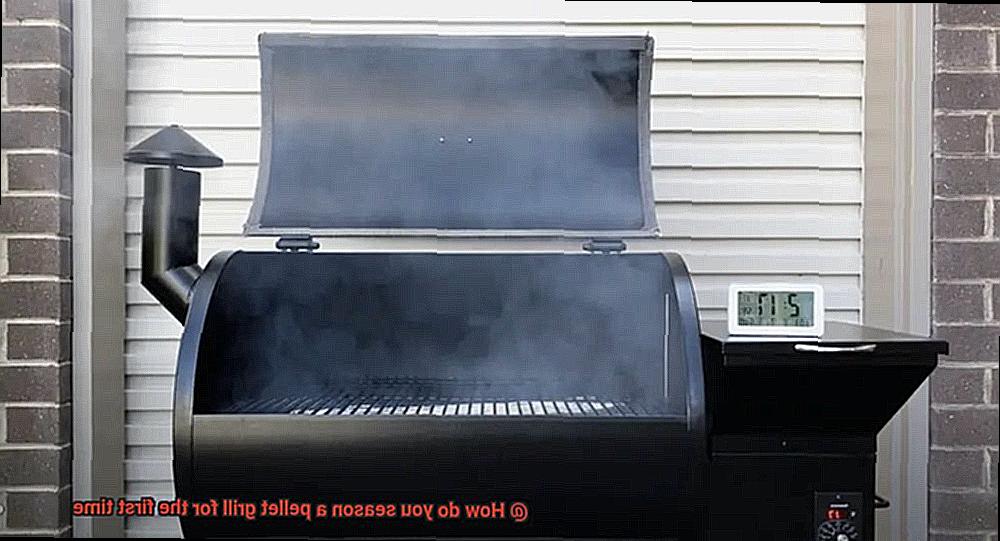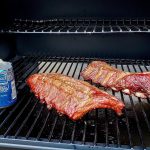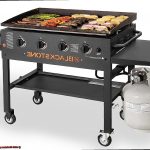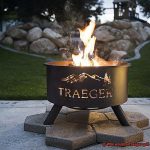Grill enthusiasts, listen up. Are you new to the world of pellet grilling and eager to get started? Well, before you can cook up a storm, there’s an essential step you need to take: seasoning your grill. It’s like giving your grill a spa day – cleaning it, protecting it, and getting it ready to cook all those juicy meats and veggies to perfection.
But don’t be fooled into thinking that seasoning is just a simple cleaning task. Oh no. It’s so much more than that. You need to heat your grill to a specific temperature and let the oils work their magic by penetrating the surfaces of your grill, lubricating the moving parts, and removing any residue left from manufacturing.
Once you’ve seasoned your pellet grill correctly, you’ll enjoy perfectly cooked meals every time. Plus, it’ll last longer and be easier to maintain. And guess what? The process is quick and easy with no special equipment required.
So in this blog post, we’re going to guide you through the simple process of seasoning your pellet grill for the first time. We’ll tell you everything you need to know about recommended temperatures and times, necessary ingredients, as well as some tips and tricks we’ve picked up along the way. By the end of this post, we guarantee that you’ll be fully equipped with all the knowledge needed to properly season your pellet grill like a pro.
Contents
Benefits of Seasoning a Pellet Grill
When it comes to pellet grilling, seasoning your grill is not only the first step, but it’s also the most important one. The process of seasoning a pellet grill involves burning off any impurities, dust, debris, or chemicals that may be present on the grill due to storage or manufacturing processes. Not only does this create a non-stick surface that makes cooking and cleaning easier, but it also has other benefits that make the effort worth it.
Here are some reasons why you should always season your pellet grill:
- Non-Stick Surface: A properly seasoned pellet grill creates a non-stick surface on the grates, making cooking and cleaning up after cooking more comfortable and efficient. You won’t have to worry about your food sticking to the grates, which can be frustrating and ruin your meal.
- Improved Flavor: Seasoning your pellet grill allows the natural oils in the wood pellets to infuse into the grill grates, enhancing the flavor of your food with a delicious smoky taste. It’s like adding an extra layer of seasoning to your dish.
- Prevents Rust and Corrosion: Pellet grills are made of metal, and metal can rust and corrode over time due to exposure to moisture and air. Seasoning a pellet grill forms a protective layer on the grates that helps prevent rust and corrosion, prolonging the life of your grill.
- Better Heat Retention: By sealing any gaps or pores in the metal grates, seasoning a pellet grill improves its heat retention capacity. This means that your grill will get hotter faster and stay hot for longer periods, which is ideal for slow cooking or smoking.
Now that you know why it’s essential to season your pellet grill let’s go over how you can do it:
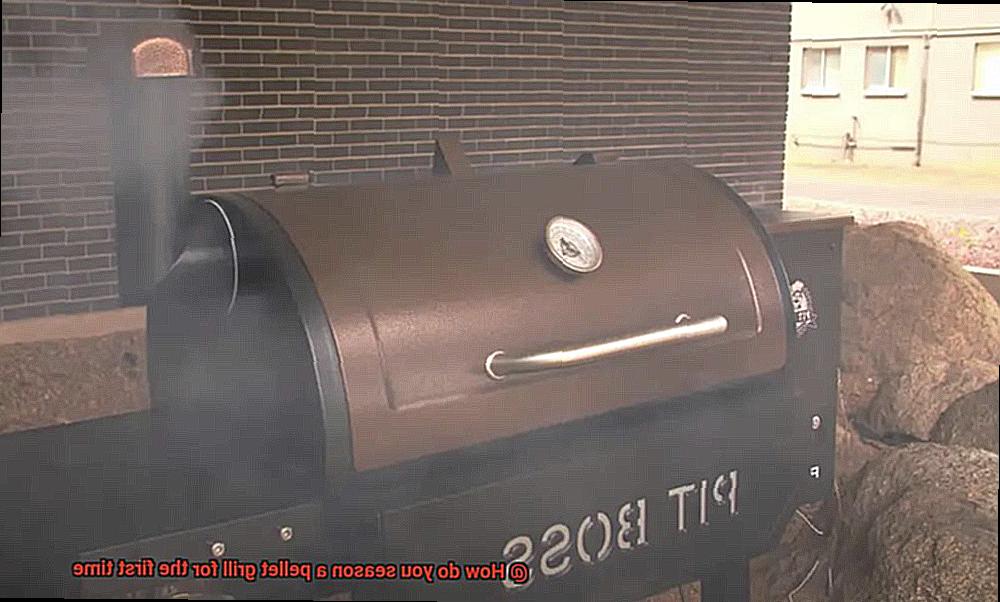
- Clean Your Grill Thoroughly: Before you begin seasoning your pellet grill, make sure to remove any packaging materials or stickers that may be on the grill. Use a wire brush or scraper to remove any debris or residue from the grates and inside the grill.
- Add Pellets and Heat Up the Grill: Add pellets of your choice to the hopper and turn on your grill. Set the temperature to 350°F and allow your grill to heat up for about 30 minutes to an hour. This will help burn off any impurities and residues that may be present on the grates and inside the grill.

What You Need to Season a Pellet Grill
If so, then it’s time to season your grill. Not only will it make your food taste better, but it will also protect your grill from rust and corrosion. Here’s what you need to get started.
Firstly, you’ll need some vegetable or canola oil, paper towels or a clean cloth, and wood pellets. The type of wood pellets you use will depend on the meat you plan to smoke. For example, hickory wood pellets are great for smoking ribs or brisket, while applewood pellets are ideal for smoking poultry or fish.
Before seasoning your grill, make sure it’s clean and free of debris. Use a grill brush or scraper to remove any leftover food particles or ash. Now it’s time to apply the oil. Pour a small amount of oil onto a paper towel or clean cloth and rub it onto the inside of the grill grates and walls. This will create a protective layer that prevents rust and ensures that your food won’t stick.
Fill the pellet hopper with your chosen wood pellets and turn on the grill. Set the temperature to 350°F and let the grill run for about 30 minutes to an hour. This will allow the oil and wood pellets to heat up and smoke, infusing your grill with that delicious smoky flavor we all know and love.
Once the initial seasoning process is complete, turn off the grill and let it cool down completely. Once it’s cooled, use a clean cloth or paper towel to wipe away any excess oil or residue.
In summary, here are the steps you need to take in order to properly season your pellet grill:
- Clean your grill
- Apply oil
- Add wood pellets
- Heat it up
- Cool down and wipe clean
Step-by-Step Instructions on How to Season a Pellet Grill
It’s time to learn how to season it like a pro. By following these simple and easy-to-follow step-by-step instructions, you’ll be able to get your grill ready for optimal cooking performance in no time.
Step 1: Clean the Grill
The first step in seasoning your pellet grill is to make sure it’s clean and free of any debris or manufacturing oils. Start by washing the grill grates with warm water and mild soap, then rinse and dry them thoroughly. Removing any excess debris or ash from the firepot and ash pan is also important. By doing this, you’ll ensure that your food doesn’t stick to the grates and that your grill is ready for optimal performance.
Step 2: Apply High-Temperature Oil
Once your grill is clean and dry, it’s time to apply a thin layer of high-temperature cooking oil. This will help protect your grill from rust and corrosion and also enhance the flavor of your food. Be sure to coat every inch of the surface evenly using a paper towel or brush.
Step 3: Preheat the Grill
Now that you’ve applied the high-temperature oil, preheat your pellet grill to 350°F and let it run for about 30 minutes. This will help burn off any remaining oil and residues on the grill. During this time, keep an eye on the temperature gauge to ensure that it remains constant.
Step 4: Cool Down and Repeat
After 30 minutes, turn off the pellet grill and let it cool down completely. Once it’s cooled, wipe away any excess oil or residue. You can repeat this process if necessary, depending on how much residue was left on the grill after cleaning.
Tips for Properly Seasoning a Pellet Grill
If you’re a fan of outdoor cooking, then owning a pellet grill is likely high on your list of priorities. But before you start grilling up a storm, it’s essential to properly season your grill. This process ensures that the grates have a non-stick surface and prevents food from sticking to them, making cleanup easier.
To help you get started, here are five tips for properly seasoning your pellet grill:
Thoroughly clean your grill
Before seasoning your grill, take the time to clean it thoroughly. Use a wire brush or scraper to remove any debris or residue from the grates and inside the grill. This step helps ensure that the seasoning process is effective.
Apply high-heat oil
Once your grill is clean, apply a thin layer of high-heat oil, such as vegetable or canola oil, to the grates. This layer of oil will create a protective barrier that prevents food from sticking to the grates and makes cleanup easier.
Heat up your grill
Turn on your pellet grill and set the temperature to 350°F. Let your grill heat up for about 30 minutes to an hour. This process helps to burn off any leftover residues from the manufacturing process.
Use high-quality wood pellets
Choose wood pellets that are specifically designed for use in pellet grills and are of high quality. You can select from various wood flavors like hickory, mesquite, or applewood.
Let it run
After adding the wood pellets, let your grill run for at least an hour. This will allow the pellets to burn and create a layer of seasoning on the grates and inside of your grill.
Remember that seasoning your pellet grill should be done periodically to maintain its non-stick surface. Regular cleaning after every use helps keep your grill in top condition and ready for use whenever you need it.
Common Mistakes to Avoid When Seasoning a Pellet Grill
Seasoning a pellet grill can be a thrilling experience, but it’s crucial to avoid common mistakes that can affect the taste, quality, and lifespan of your grill. Here are some essential tips to ensure you don’t make any mistakes:
One of the most significant mistakes you can make when seasoning a pellet grill is not cleaning it thoroughly before use. Any debris or residue from previous grilling sessions can impact the flavor of your food and cause flare-ups, so grab a grill brush or scraper and wipe down the grates with a damp cloth.
Another mistake to avoid is not using enough oil when seasoning. Coating the grates with oil prevents food from sticking and rusting, and high-heat oils such as vegetable or canola oil work best. Apply the oil with a brush or paper towel to ensure even distribution.
It’s vital to let your pellet grill heat up for at least 15-20 minutes before adding any food. This allows the grill to reach its optimal temperature and ensures even cooking. If you add food too soon, it may not cook evenly or may stick to the grates.
Using too much heat is another common mistake that many people make when seasoning their pellet grill. While it may seem tempting to crank up the heat, doing so can cause flare-ups and burn your food. Follow the manufacturer’s instructions for recommended cooking temperatures and adjust as needed.
Monitoring the temperature of your pellet grill throughout the cooking process is another crucial aspect of ensuring an even cook and preventing flare-ups. Use a meat thermometer or digital thermometer to check the temperature of your food and adjust the grill temperature as needed.
Cleaning and Maintaining Your Pellet Grill After Seasoning
Now that it’s ready for use, it’s important to give it the care and attention it deserves to ensure longevity and optimal performance. In this article, we’ll take a closer look at how to clean and maintain your pellet grill after seasoning.
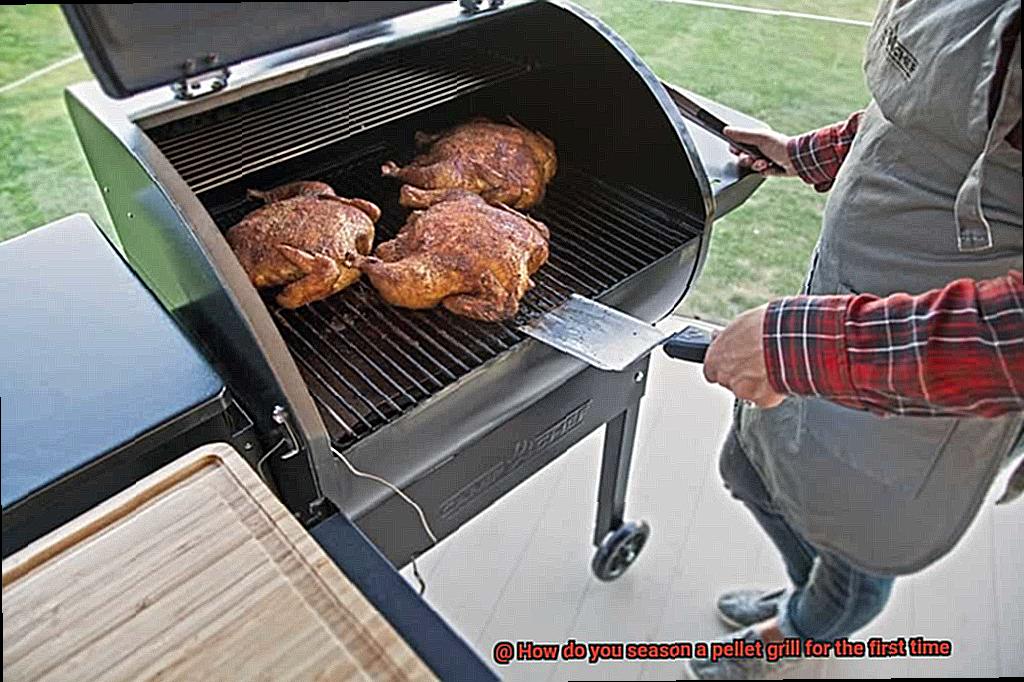
The first step is to let your grill cool down completely before cleaning. Once it’s safe to handle, remove the grates and give them a good scrub with warm soapy water and a grill brush. Stubborn stains can be tackled with a mixture of baking soda and water. Rinse the grates thoroughly with water once you’re done.
Next, remove the drip tray and empty it of any leftover ash or grease. Use warm soapy water and a sponge to clean it thoroughly. For tough stains, try using a grill cleaner.
Now it’s time to wipe down the interior of the grill with a damp cloth, making sure to clean every nook and cranny, including the walls, ceiling, and bottom of the grill. Once everything is clean, reassemble the grates and drip tray. Before using the grill again, double-check all connections for security and leaks.
To keep your pellet grill in top condition, it’s important to maintain it regularly. Check the hopper for any debris or pellets that may have become stuck. Additionally, empty and clean out the ash pan after each use.
Additional Considerations When Seasoning a Pellet Grill
Before you embark on your culinary journey, there’s one critical step that you cannot overlook: seasoning your grill. However, there are some additional considerations that you should keep in mind to guarantee top performance and delicious food for years to come.
The type of pellets you use during the seasoning process is crucial. Invest in high-quality pellets made from 100% hardwood with no fillers or binding agents. The premium quality of the pellets will provide a consistent burn and ensure that no contaminants affect the flavor of your food.
Seasoning your grill only once is not enough. While it’s recommended to do so before its first use, it’s also essential to re-season it periodically to maintain its optimal performance. This is particularly important if you’ve made significant modifications to your grill or haven’t used it for an extended period.
Temperature control is another crucial factor that you should not overlook. Consistent temperature throughout the seasoning process is paramount to ensuring quality seasoning and ultimately producing high-quality food. So, be sure to monitor the temperature carefully and make adjustments accordingly.
Finally, keeping your pellet grill clean throughout the seasoning process is vital. Regular cleaning prevents any buildup of grease or debris that can affect the performance of your grill and potentially cause safety hazards.
6eVSQ9HfYB8″ >
Conclusion
In conclusion, if you want to savor delectable and evenly cooked meals every time, seasoning your pellet grill is an indispensable step. Not only does this process create a non-stick surface that makes cooking and cleaning effortless, but it also offers other benefits that make the effort worthwhile. By burning off any impurities, dust, debris or chemicals that may be present on the grill due to storage or manufacturing processes, you can enhance flavor, prevent rust and corrosion, and improve heat retention.
Luckily for you, seasoning your pellet grill is a breeze and requires no special equipment. All you need are some vegetable or canola oil, paper towels or a clean cloth, and wood pellets of your choice. Simply follow these easy steps: clean your grill thoroughly; apply high-temperature oil evenly on all surfaces of the grates and walls; heat up your grill to 350°F for about 30 minutes to an hour while adding wood pellets of your choice to infuse that mouthwatering smoky taste into your grill.
To ensure optimal performance and longevity of your pellet grill after seasoning it’s important to maintain it regularly by checking the hopper for any debris or pellets that may have become stuck and emptying out the ash pan after each use. Additionally, investing in high-quality pellets made from 100% hardwood with no fillers or binding agents will provide a consistent burn and ensure that no contaminants affect the flavor of your food.

